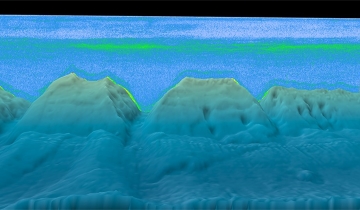721224_False Bottom_360 px width_cropped.jpg

A sonar scan in the North Atlantic Ocean. The green indicates the deep scattering layer, where there are lots of organisms congregate and give sonar a "false bottom" above the seafloor. Credit: NOAA Okeanos Explorer, Elliot Lim.
Early in World War II, the Navy began using sonar to probe for enemy U-boats. Ships would send out pulses of sound, then measure their reflection to figure out what was below. But early observations revealed something a little disconcerting: The ocean floor wasn’t where it was supposed to be—it was a lot closer to the surface. Sonar operators thought they might be seeing uncharted underwater islands.
But scientists soon came up with another explanation. Sonar was revealing a “false bottom”—a layer with so many small fish and other organisms that it was reflecting the sonar. It was named the deep scattering layer.
It’s found in most of the world’s oceans, generally at depths of a thousand to 1500 feet. It’s part of the daily migration of the critters that live there.
During the day, they go deep because little or no sunlight penetrates that far. That allows them to hide from predators—most of the time. Dolphins and other predators sometimes dive through the layer, scooping up some tasty treats. The schools of fish, squid, and crustaceans bunch closer together when they’re attacked.
At night, they rise close to the surface, where they feed on tiny organisms. At dawn, they start back down again.
The main inhabitants of the scattering layer are lanternfish. They’re only a few inches long, but they’re plentiful. Their swim bladders are especially good at reflecting sonar—creating a false bottom in images of the deep ocean.

